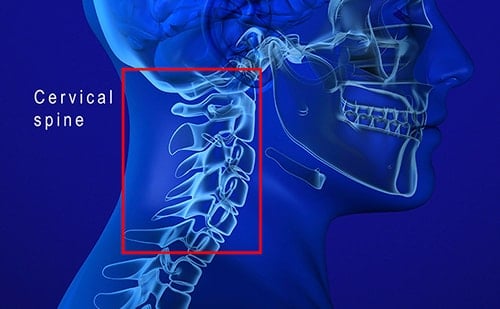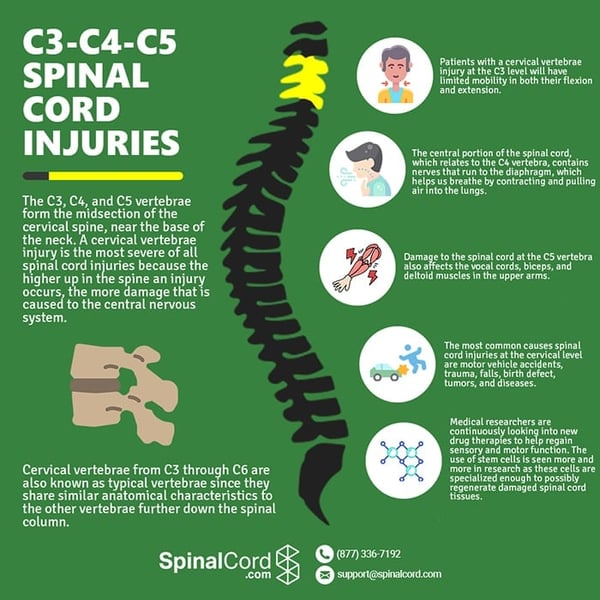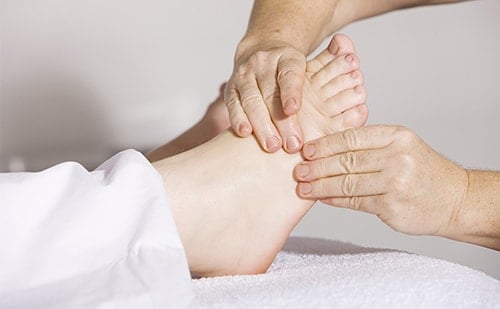C3, C4, & C5 Spinal Injuries
C3, C4, and C5 spinal cord injuries can be life-threatening and permanently alter ones lifestyle.
Watch Our Video
C3, C4, and C5 spinal cord injuries can be life-threatening and permanently alter ones lifestyle.
Watch Our VideoThe C3, C4, and C5 vertebrae form the midsection of the cervical spine, near the base of the neck. A cervical vertebrae injury is the most severe of all spinal cord injuries because the higher up in the spine an injury occurs, the more damage that is caused to the central nervous system. Depending on the severity of the damage to the spinal cord, the injury may be noted as complete or incomplete.

The C2 - C3 junction of the spinal column is important, as this is where flexion and extension occur (flexion is the movement of the chin toward the chest and extension is the backward movement of the head). Patients with a cervical vertebrae injury at the C3 level will have limited mobility in both their flexion and extension.
The C3 vertebra is in line with the lower section of the jaw and hyoid bone, which holds the tongue in place. The flexible C3 vertebrae helps aid in the bending and rotation of the neck.
This central portion of the spinal cord, which relates to the C4 vertebra, contains nerves that run to the diaphragm, which helps us breathe by contracting and pulling air into the lungs. The C4 vertebra is located in the neck region of the spinal column, just above the thoracic vertebrae. It is located in close proximity to the thyroid cartilage.
The C5 spinal vertebra is the fifth vertebra from the top of the column. The C5 vertebra is significant for determining the severity of neck and spinal injury. If the injury is at or above the C5 vertebra, the person may be unable to breathe since the spinal cord nerves located between the third and fifth cervical vertebrae control respiration. Damage to the spinal cord at the C5 vertebra also affects the vocal cords, biceps, and deltoid muscles in the upper arms.
The most common causes of cervical vertebrae injury and spinal cord damage include a spinal fracture from diving accidents and sports, as well as medical complications. Other common causes include:
Cervical vertebrae from C3 through C6 are also known as typical vertebrae since they share similar anatomical characteristics to the other vertebrae further down the spinal column. Typical vertebrae share these features:
The thick boned vertebral body is cylindrical-shaped and located at the front of the vertebra. It carries most of the weight for a vertebra. Most vertebrae feature an intervertebral disc between 2 vertebral bodies for cushioning and shock absorption.
The vertebral arch is a bony curve that wraps around the spinal cord toward the back of the spine and consists of 2 pedicles and 2 laminae.
Each vertebra has a pair of facet joints, also known as zygapophysial joints. These joints, located between the pedicle and lamina on each side of the vertebral arch, are lined with smooth cartilage to enable limited movement between 2 vertebrae. Spinal degeneration or injury to the facet joints are among the most common causes of chronic neck pain.
These vertebrae form the midsection of the cervical spine, near the base of the neck. They control function to the body from the shoulders down. All three vertebrae work together to support the neck and head.
The C3,C4, and C5 vertebrae are part of the cervical spinal column. There are seven vertebral levels in total in this region, known as C1-C7. These vertebrae protect the spinal cord running through the cervical region of the spine, as well as provide support for the neck and head.
The C3, C4, & C5 vertebrae form the midsection of the cervical spine. C3 - C5 cervical vertebrae injuries tend to be severe because the central nervous system is more damaged.

Symptoms of a spinal cord injury corresponding to C3 vertebrae include:
Patients with C4 spinal cord injuries typically need 24 hour-a-day support to breathe and maintain oxygen levels. Symptoms of a spinal cord injury corresponding to C4 vertebrae include:
Damage to the spinal cord at the C5 vertebra affects the vocal cords, biceps, and deltoid muscles in the upper arms. Unlike some of the higher cervical injuries, a patient with a C5 spinal cord injury will likely be able to breathe and speak on their own. Symptoms of a spinal cord injury corresponding to C5 vertebrae include:
Unfortunately, there is no treatment which will completely reverse the spinal cord damage from a cervical vertebrae injury at the C3 - C5 levels. Medical care is focused on preventing further damage to the spinal cord and utilization of remaining function.
Current treatments available for patients are:
A spinal fracture may be remedied with surgery, but the abnormal movement of vertebrae or pieces of bone can cause a more severe spinal cord injury.

It is an unfortunate truth that there are not many options to date to completely recover from a cervical spinal cord injury. Medical researchers are continuously looking into new drug therapies to help regain sensory and motor function. The use of stem cells is seen more and more in research as these cells are specialized enough to possibly regenerate damaged spinal cord tissues. Lab study results show greater sensory and motor function in those patients treated with stem cells for spinal cord damage.
Spinal cord injuries are traumatic for patients and their families. They cause disruptive changes to every aspect of your life and there is a lot of new information to navigate and understand. Our experts have collected everything in one place to help you learn more about your injury, locate doctors and treatment centers, find financial support, and get assistance navigating your next move.
Sponsored by Tampa personal injury lawyers at Swope, Rodante P.A. a Florida law firm located at 1234 E 5th Ave, Tampa, FL 33605.
The information provided by SpinalCord.com is not a substitute for professional medical advice, diagnosis, or treatment, see Disclaimer Policy.